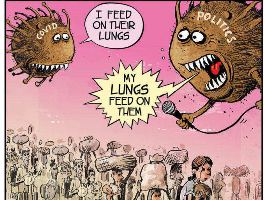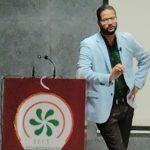The Flame Casts No Shadow
Trailokya Jena
Part-I considered the basic situation of labour migration in India and the barriers to sound policy interventions and meaningful planning for lack of reliable data. The prevailing situation of migrants’ movements inside the country closely resembles animal migration seen daily on National Geographic and Animal Planet channels where the quotient of casualty during journey and on arrival at destination points is equally predatory, repetitive and lawless for both humans and animals. And when the process gets caught up in a pandemic situation catastrophe is inevitable as the movements of the migrants on the road has the same fatalism associated with the herd crossing river streams seen on tv screens. The dynamics of a crisis are not especially conducive for rational application of either science or social science. State capacity, the limits of which has been already discussed in Part-I, either easily gets overwhelmed or gets terribly under or misutilised. Sometimes it becomes too much for civil society to handle or, as in the case of our lockdowns, too much restraint is placed upon civil society to contribute. In this light it should be worthwhile to examine the sequence of events and the way it impacted the crisis.
Timely evacuation of students fro China, a voluntary dry run in form of Janata Curfew at the behest of the PM observed on March 22 was followed quickly by Lockdown 1.0 on March 24. Before that the PM had a video conference with most CMs on March 20 but it is not known if the migrant labour situation was discussed and if so to what extent. In this era of fake news and sharp political polarisation within information provider it is not easy to find the truth. Not that inter state migrants had not faced mass exodus home before, but those instances were confined to specific places involving specific population group and the situations were not constrained with a nation wide lockdown completely halting all movements throughout the country. On Marc h 25 the migrant workers realised, or some say instigated, that unlike in the past moving out of their current location and travelling to States of origin will not be possible. Then trouble started initially in Delhi next day, spontaneously or by design depending on whose narrative one would buy (being discussed shortly) and as the migrants started to feel the severity of the lockdown, the anxiety and uncertainty of all migrants started spreading to different parts of the country. As days passed by their difficulties relating to shelter and food increased. Finding no other means to travel they took their feet to walk home irrespective of the distance. Neither the host States nor the Centre made quick and decisive intervention as the usual blame game commenced and the media fuelled it according to political orientation and economic vested interest. TV cameras just feasted on migrants’ plight as endless footages kept streaming on the screen, and are still streaming. These human objects of urban consumption were discarded from the social shelf for self disposal on wide open landscape with media reporting the process live. The role of the three agencies involved in this human tragedy, the governments, media and consuming public, has to be examined closely.
First the government which started well in taking right initiatives in the context of the pandemic challenge. It took the bold decision on international flights, especially from China, and the early lockdown. But what seems to have undid it is perhaps the lack of political and social consultation within the governance system as a top down leadership completely marginalised the political representatives entrusting all measures in the hands of the bureaucracy. The ministers and the parliamentarians were mostly out of the picture as they got up caught up in the lockdown, and still are, as they got confined to Delhi, or State Capitals in cases of legislature, still out of touch with people of their constituencies even now. A few better performing States though engaged best available professional talent to manage the pandemic response. Kerala entrusted full responsibility to its Health Minister Shailaja, Odisha engaged a management expert, Delhi put a capable health specialist in charge. But the centre, having taken full control of the country after promulgation of the Epidemic Act and the Disaster Act, relied on the ministry bureaucrats remote controlled from above. The daily briefing led by a Joint Secretary of the Ministry has been in sharp contrast to national and global best practices. A bureaucracy led planning and response neither anticipated nor understood the predicament of migrant labourers caught in the firm grip of a draconian lockdown that, to be fair, was the need of the hour. The lack of comprehension of the economic compulsions of migrants from far corners of the country and the lack of human understanding of them as a group, something that comes so naturally to political representatives, the bureaucratic control of pandemic management got gapingly exposed leaving the media, and the opposition, to have a field day. I’m not dwelling more on the bureaucratic response to all aspect of pandemic management as its role will be subjected to critical examination of the question of accountability to be dealt in the next and final part.

The extremely polarised media in our country has transgressed its role from the Fourth Estate to increasingly devour areas falling within the domain of other estates. In a country where the Legislature has been reduced to getting filled by either feudal vassals or subordinate lease holders of powerful party bosses, where the Judiciary is getting increasingly capricious and omniscient by the day, and where the executive is defined more by loyalty than competence and integrity, the remaining pillar, fourth estate, has found it easy to hijack the political landscape. Today part of the media is the virtual opposition while the other part is a committed government wing. More dangerous is the usurping of political roles and goals by media opinion leaders and propagation of their different schools of thought for the governance of the country. You can almost say that the polity for quite sometime is suffering from Rajdeep Sardesai school of thought, Ravish Kumar school of thought, Arnab Goswami school of thought, Barkha Dutt school of thought to which one can keep on expanding bringing in Sagarika Ghosh, Sudhir Chaudhry, Anjana Om Kashyap, Karan Thapar (can’t add more names as my viewing of tv is largely limited to sport) and all kinds of media loonies, psychos, pansies into the equation. This group of media pundits control the contours and directions of public discourses in the country which legitimately belong to elected representatives, respected academicians, public intellectuals and qualified think tanks. Instead they, with their opaque intellectual credentials, selfish hidden agenda, and psychopathic ambitions, are practically controlling national politics, directing political personalities and parties and constantly distorting the political discourse of the country. More damaging, in constant quest for TRP, the media is always impatient to dictate quick fix solutions on the screens of live tv before the next commercial break. The net result is constant bullying of other three democratic pillars by the Fourth Estate thereby hugely undermining our already crumbling democracy. With this institutional decline of the Parliament and State legislatures our tv studios have assumed itself as the greatest deliberative arena to decide what the nation wants to know and get done. In addition to big corporate houses, every thug in the country masquerading as social and political leader of varying stature runs a tv channel (we have more than 850 tv channels as per 2018 statistics) that greatly contribute to the chaos. The greed and prosperity of these thugs mired in deep layers of corruption and even crime are gleefully feeding on the hunger and despair of the poor as the accompanying cartoon shows.
Add this to the chaos that is social media, you’ve a complete breakdown of constructive approach to national problems. The social media is full of paranoia inducing fake news where it is impossible to decipher fact from fiction. It is alleged that some of the visuals of migrant plight are projected through fake pictures of past events and even some photos circulating are from neighbouring countries, as if such doctored images are really necessary to prove any point! It has assumed great power to influence public opinion and action without having an iota of responsibility and accountability. The migrant crisis has been exponentially influenced by mainstream and social media where the genesis and course of the crisis are determined according to rival political agenda. I do not remember if at anytime the media has offered constructive suggestions to the migrants or offered advice on the disease implication they will bring to their native surroundings including their own families. While the central government was clueless in either anticipating or managing the crisis, the media completely seized the event to use it every which way but constructively. They have simply ratcheted up public emotion by repeatedly airing degrading images of the poor to create panic and force hasty actions by the authorities to usher in a competitive populist race by different governments. These clever manipulations of both politics and economics of migrant misery has induced competitive welfare action by States. You can now find frequent politicised election oriented advertisements by State governments distributing clothe, food and chappals to migrants within their State boundaries which is payback time to tv channels for their rolling spectacle of migrants’ misery which is no less degrading to their dignity either. The media now is the government, and also the opposition. It is actually fixing the agenda and running the country.
That brings us to the response of the civil society. It is a fact the the access of civil society to the road migrants are walking has been severely curtailed by the lockdown rules. But deep down do we really care for them who have been nothing but items of consumption for us at various times of need. What have we done so far, and planning to do now, when we see them falling through the cracks of governance on live tv?
Pratap Bhanu Mehta, perhaps our best known political scientist and public intellectual who often gets castigated by both sides of our political divide, has come out with some deep perspectives on the issue in his columns. His point is that our society through the media, academics, intellectuals, opinion leaders have conspired for long to make these migrants invisible to begin with. The full impact of the images displaying their lack of identity, poverty, inequality, vulnerability has not registered in our consciousness ever. The current fate of the migrants who are being humiliated in getting reduced from a self respecting workforce to the levels of beggars forced to live on charity only elucidate our half regretful lament rather than fully articulated outrage. Mehta questions whether the migrants need only our pity and sympathy or full justice. And what should be the right framework of justice under which they are to be treated by the State.
The civil society at their originating places treat the migrants no better. States which have forced them to migrate in the first place for its incompetence but have never hesitated to live on their earnings, have been hesitant and even downright reluctant to accept them back at this pandemic time. The horror of their compatriots at the risk of their home return is bizarrely inhuman. It puts even the treatment of Kafka’s bread earning protagonist by his family after his metamorphosis to a giant bug to deep shade.
To be fair, you can’t put all the blame on civil society as it is constantly manipulated by the media which creates a statistical maze around the disease bombarding you day and night with various sets of numbers( easy for a nation fed with cricket and cricketers’ statistics) and what all this is going to do to you. In this game of pandemic statistics where States compete with one another to protect their averages of corona numbers, the migrants are the victim of lack of statistics which deny them basic identity and social benefits which is their due. Question that naturally arises here is whether we are a compassionate society. My impression is yes, we are and this is reinforced by a recent Delhi incident. A street side mango seller was forced to leave his stuff on the pavement for a few minutes during which bye passers looted his entire stock thereby pauperising him. This news was carried on national media and appeal was made to help the mango seller. As I write this it is gathered that the public has been outraged by the incident and has contributed a few lakh to help him restart his life. We are certainly a compassionate society and are capable of great humanitarian acts given the right direction and opportunity. The sad thing about our larger crisis here is that our civil society gets manipulated by partisan media and self serving politicians away from mobilising constructive emotion and action towards deeply divisive and selfish agenda. The whole tragedy of the migrants is that though they have been burning themselves for nation building at places far wary from where they were born, their flame in the lead picture, does not cast a shadow.
( Jena, former principal chief commissioner of Income Tax, will deal with the questions on accountability and future measures on the concluding part next)







